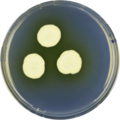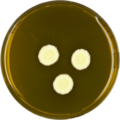Aspergillus taichungensis
| Aspergillus taichungensis | |
|---|---|
| Scientific classification | |
| Domain: | Eukaryota |
| Kingdom: | Fungi |
| Division: | Ascomycota |
| Class: | Eurotiomycetes |
| Order: | Eurotiales |
| Family: | Aspergillaceae |
| Genus: | Aspergillus |
| Species: | A. taichungensis
|
| Binomial name | |
| Aspergillus taichungensis Yaguchi, Someya & Udagawa (1995)[1]
| |
Aspergillus taichungensis is a species of fungus in the genus Aspergillus. The species was first described in 1995.[1] It is from the Candidi section.[2] The fungi in the Candidi section are known for their white spores.[2] It has been isolated from soil in Taiwan.[1] A. taichungensis has been shown to produce candidusin C, terphenyllin, and 3-hydroxyterphenyllin.[2]
The genome of A. taichungensis was sequenced as a part of the Aspergillus whole-genome sequencing project - a project dedicated to performing whole-genome sequencing of all members of the genus Aspergillus.[3] The genome assembly size was 27.12 Mbp.[3]
Growth and morphology
Aspergillus taichungensis has been cultivated on both Czapek yeast extract agar (CYA) plates and Malt Extract Agar Oxoid® (MEAOX) plates. The growth morphology of the colonies can be seen in the pictures below.
-
Aspergillus taichungensis growing on CYA plate
-
Aspergillus taichungensis growing on MEAOX plate
References
- ^ a b c Yaguchi, Takashi; Someya, Ayako; Udagawa, Shun-ichi (1995). "Aspergillus taichungensis, a new species from Taiwan". Mycoscience. 36 (4): 421–424. doi:10.1007/BF02268626.
- ^ a b c Varaga, J.; Frisvad, J.C.; Samson, R.A. (2007). "Polyphasic taxonomy of Aspergillus section Candidi based on molecular, morphological and physiological data". Studies in Mycology. 59: 75–88. doi:10.3114/sim.2007.59.10. PMC 2275198. PMID 18490951.
- ^ a b "Home - Aspergillus taichungensis IBT 19404 v1.0". genome.jgi.doe.gov.


